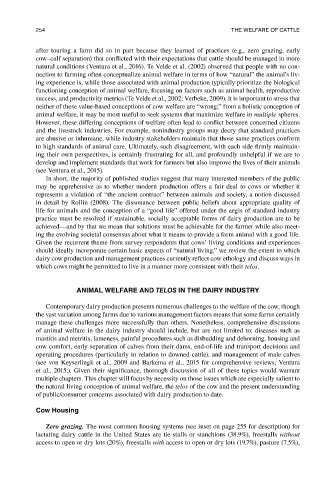Page 277 - The Welfare of Cattle
P. 277
254 the WeLfare of CattLe
after touring a farm did so in part because they learned of practices (e.g., zero grazing, early
cow–calf separation) that conflicted with their expectations that cattle should be managed in more
natural conditions (Ventura et al., 2016). Te Velde et al. (2002) observed that people with no con-
nection to farming often conceptualize animal welfare in terms of how “natural” the animal’s liv-
ing experience is, while those associated with animal production typically prioritize the biological
functioning conception of animal welfare, focusing on factors such as animal health, reproductive
success, and productivity metrics (Te Velde et al., 2002; Verbeke, 2009). It is important to stress that
neither of these value-based conceptions of cow welfare are “wrong;” from a holistic conception of
animal welfare, it may be most useful to seek systems that maximize welfare in multiple spheres.
However, these differing conceptions of welfare often lead to conflict between concerned citizens
and the livestock industries. For example, nonindustry groups may decry that standard practices
are abusive or inhumane, while industry stakeholders maintain that those same practices conform
to high standards of animal care. Ultimately, such disagreement, with each side firmly maintain-
ing their own perspectives, is certainly frustrating for all, and profoundly unhelpful if we are to
develop and implement standards that work for farmers but also improve the lives of their animals
(see Ventura et al., 2015).
In short, the majority of published studies suggest that many interested members of the public
may be apprehensive as to whether modern production offers a fair deal to cows or whether it
represents a violation of “the ancient contract” between animals and society, a notion discussed
in detail by Rollin (2008). The dissonance between public beliefs about appropriate quality of
life for animals and the conception of a “good life” offered under the aegis of standard industry
practice must be resolved if sustainable, socially acceptable forms of dairy production are to be
achieved—and by that we mean that solutions must be achievable for the farmer while also meet-
ing the evolving societal consensus about what it means to provide a farm animal with a good life.
Given the recurrent theme from survey respondents that cows’ living conditions and experiences
should ideally incorporate certain basic aspects of “natural living,” we review the extent to which
dairy cow production and management practices currently reflect cow ethology and discuss ways in
which cows might be permitted to live in a manner more consistent with their telos.
aNIMaL WeLFare aND TELOS IN the DaIrY INDUStrY
Contemporary dairy production presents numerous challenges to the welfare of the cow, though
the vast variation among farms due to various management factors means that some farms certainly
manage these challenges more successfully than others. Nonetheless, comprehensive discussions
of animal welfare in the dairy industry should include, but are not limited to: diseases such as
mastitis and metritis, lameness, painful procedures such as disbudding and dehorning, housing and
cow comfort, early separation of calves from their dams, end-of-life and transport decisions and
operating procedures (particularly in relation to downed cattle), and management of male calves
(see von Keyserlingk et al., 2009 and Barkema et al., 2015 for comprehensive reviews; Ventura
et al., 2015;). Given their significance, thorough discussion of all of these topics would warrant
multiple chapters. This chapter will focus by necessity on those issues which are especially salient to
the natural living conception of animal welfare, the telos of the cow and the present understanding
of public/consumer concerns associated with dairy production to date.
Cow housing
Zero grazing. The most common housing systems (see inset on page 255 for description) for
lactating dairy cattle in the United States are tie stalls or stanchions (38.9%), freestalls without
access to open or dry lots (20%), freestalls with access to open or dry lots (19.7%), pasture (7.5%),

